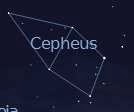Cepheus is somewhat fainter than better-known constellations. But, it is easy to find, since parts of several prominent constellations point to it. It is between Cassiopeia, "the W", and Cygnus, the Northern Cross. The easternmost leg of the W and the head of the Cross both point to it. If you extended northward the lines which form the east and west sides of Pegasus's "square" they would intersect in Cepheus.
Some people think of Cepheus as a pentagon, others say it looks like a house a child might draw. In Greek mythology, Cepheus was the king of Ethiopia. His wife, the queen, was Cassiopeia. His daughter was Andromeda, whose constellation extends out from the northeast star in the square of Pegasus.
Cepheus is a circumpolar constellation for observers in the northern hemisphere. That means it is positioned close enough the North Star (which it appears to circle daily and yearly) so that it never sets..
Delta Cephei is a very famous and important star. It more than doubles its brightness, and fades back, over a regular period of 3 days, 5 hours, 37 minutes. Its name is used for a whole class of pulsating variable stars which behave similarly. If one knows the length of the period over which a Cepheid variable star varies, one can calculate its luminosity. Luminosity is the absolute brightness of a star – how bright it would appear if all stars were at the same distance from the observer. Using these calculations, about 100 years ago, astronomers found that the distance of one Cepheid variable in the Andromeda galaxy was about 3 million light years away. So it confirmed the Andromeda group of stars was far outside our Milky Way galaxy, and was itself a galaxy. Since then, it has been regularly used to calculate distances to star clusters and galaxies.
Another famous variable star in Cepheus is Mu Cephei, known as the Garnet Star, because of its striking red color





No comments:
Post a Comment